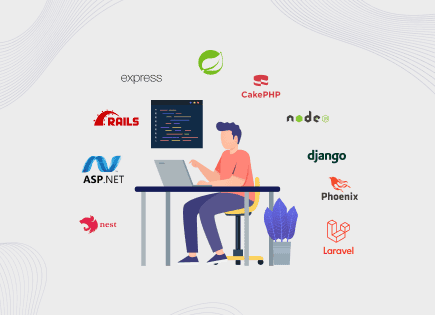Table of Content
Next.js vs. Node.js: Choose the Right Framework for App Development
Table of Content
 Should you stick with the current heavyweight Node.js or go with the “next” big thing, Next.js?
Should you stick with the current heavyweight Node.js or go with the “next” big thing, Next.js?
Let us show you what's buzzing in web development—picking the right framework could save you countless development hours!
Developers like you make important decisions about their tech stack every day. As fellow developers, we are here to support you in making that winning choice!
Here's something revolutionary: With 17.90% of votes, Next.js shot to rank fourth most often used framework according to the 2024 Stack Overflow Survey!
Node.js is smashing it with 40.8% developer preference meanwhile. These figures might change your approach to development!
 The discussion of programming languages of the future is redefining industry standards! Want proof? Nodejs usage tripled in 2024 compared to last year. That's the kind of growth that could give your projects a competitive edge!
The discussion of programming languages of the future is redefining industry standards! Want proof? Nodejs usage tripled in 2024 compared to last year. That's the kind of growth that could give your projects a competitive edge!
By the end of this blog, we’re confident that you’ll be able to choose between Next.js vs. Node.js. You'll understand which one aligns perfectly with your project goals, team size, and scalability needs.
Let's explore how these development frameworks compare and which might be the best fit for your project.
Next.js vs. Node.js Compared
Modern application development calls for careful evaluation of the frameworks you decide to use.
Your development speed and success can be much influenced by the decision between these potent technologies.
This is the thorough Next.js vs Node.js comparison to guide your choice.
 1. Approach
1. Approach
Every framework follows a different road to enable you to reach your objectives for application.
Each framework treats development differently as follows:
The Next.js Approach:
React components with automatic file system routing from your frontend development's main focus.
Handle rendering using a hybrid strategy combining flexible server-side and stationary generation.
Use built-in features handling anything from graphics to code splitting to automatically optimize speed.
Easily create full-stack applications by including API routes into your frontend architecture.
The Node.js Approach:
Node.js using event-driven architecture and custom configurations, totally controls your server environment.
Using non-blocking I/O and asynchronous programming, effectively run several operations.
Control resources concurrently using a single-threaded event loop.
Apply horizontally in scale and keep constant performance throughout dispersed systems.
2. Architecture
Choosing either Node.js or Next.js affects your implementation of basic functionality. Every framework offers different tools to improve your process of development.
Features of Next.js:
Your programs have server-side rendering capabilities, therefore rapidly delivering optimal content to users.
Create static sites with low hosting expenses and lightning-fast loading.
Automatically transform and improve photos to raise the performance measures on your website.
Create lovely interfaces with integrated Sass and CSS support without further configuration.
Features of Node.js:
For complicated processes, apply server-side logic using an easily maintainable code structure.
With help from several database systems, effectively handle database tasks.
Easy process file system operations, made possible by built-in modules and streams.
Create dynamic real-time programs that grow with your user count.
3. Functions
Knowing the features of Node.js or Next.js will enable you to choose better for your projects.
Next.js Features:
Your pages show on the server and provide your users with the best content.
Create quickly loading static sites to drastically lower server demand.
Automatically improve the efficiency of your site with built-in tools for image optimization.
Right from the box, create elegant interfaces utilizing integrated CSS and Sass support.
Node.js Features:
Control complicated server processes while keeping a neat, orderly code base.
Control database transactions with strong drivers for several database systems.
Using built-in modules and streaming features, process files quickly.
Write real-time programs managing hundreds of concurrent connections.
Looking to Build High-Performance Web Apps?
Hire expert Next.js & Node.js developers for fast, scalable, and secure solutions.
Get Started Today!
4. Routing
Every framework approaches routing in a different way, which influences your application architecture. Let’s see how they handle page navigation and URL patterns differently.
Next.js Approach:
Your “pages” directory generates related paths automatically without any setting required.
Brackets to your file names will help you to create dynamic paths.
Use shallow routing to change the URL without performing techniques of data-fetching.
Perfect for authentication flows, add middleware to handle requests before they finish.
Node.js Approach:
Manually route using Express.js for controlled URL handling.
Specify custom patterns for flexible navigation that match particular URL chunks.
Design reusable middleware to handle inquiries via several paths.
Create sophisticated routing systems fit for the particular requirements of your application.
5. SEO-Friendliness
The SEO skills of the Next.js vs Node.js comparison show notable variances. Knowing these variations enables you to decide better for the visibility of your project.
Next.js Features:
Your pages naturally have built-in SEO optimization straight out of the box.
Effective search engine crawling of your material depends on server-side rendering.
Create static sites search engines adore to index and rank.
Easily control meta tags using built-in head components to improve ranks.
Node.js Considerations:
Arrange extra tools and setups to get rendering with SEO friendliness.
Manual server-side rendering will help to increase search engine visibility.
Customise solutions for content optimization and meta tag management.
Add outside packages to properly manage SEO needs.
6. APIs
Comparing Node.js vs Next.js reveals different methods of API implementation. Every framework presents different approaches to building and controlling your API endpoints.
Next.js Approach:
Create API routes straight from your pages or API directory without further setup.
Manage server-side logic inside the same project as frontend code.
Use serverless capabilities that grow naturally with your application demand.
Create edge functions for quicker response times over various areas.
Node.js Approach:
Create tailored API endpoints under total control over server deployment.
Organize your paths using widely used middleware like Express for better code.
Independent from your frontend applications, scale your API services.
Design microservices with efficient distribution of your API capability.
7. Applications
Your project needs will determine whether frontend development calls for Node.js or Next.js. Every framework excels in particular applications and development contexts.
Next.js:
E-commerce sites requiring quick page loads and outstanding SEO capability
Content-heavy websites, including news sources and blogs, call for server-side rendering.
Marketing websites enabled by static page-generating features
Enterprise applications demand both dynamic and stationary content processing.
Node.js:
Collaboration tools and chat systems among real-time applications
Streaming systems effectively manage ongoing data flow
REST API providers needing highly performance backend operations
Microservices design supporting distributed systems on a scale
Looking to Hire Next.js & Node.js Developers?
Hire expert Next.js & Node.js developers for fast, scalable, and secure solutions.
Schedule a Call!
Next.js: A Reactive Frontend Framework
Next.js keeps leading as the most popular front end frameworks as web development changes. Next.js is unique among reactive development solutions for this reason.
Brief History
Vercel developed Next.js in 2016 to solve React app client-side rendering restrictions. Since then, it has developed into a whole framework fit for React apps ready for production.
Standout Features
Knowing why and how to use Next.js assists developers in deciding their tech stack.
1. Zero Configuration:
Start right now with automatic bundling and box compilation.
Make use of built-in TypeScript capabilities without complicated setup needs.
2. Hybrid Rendering:
Create lightning-fast pages with choices for static creation and configurable server-side rendering.
Dynamic update stationary information with gradual static regeneration features.
Create static pages for better SEO and performance right during building.
3. Performance Optimization:
Split codes to provide your users with the just required JavaScript automatically.
Automatically size photographs on demand using contemporary format conversion.
Load custom fonts without influencing page performance or generating layout changes.
While Next.js alternatives exist, its special qualities provide a remarkable development experience.
When to Use Next.js?
Next.js is fit for a broad spectrum of application. You have to evaluate your use case to find if Next.js fits your project or not. Next.js shows to be a great choice in the following situations.
Next.js shines most here::
Create search engine optimistically optimized React apps preferred by search engines to crawl and index
Create quickly loading static websites to cut your hosting costs.
Start e-commerce projects with outstanding usability and performance capabilities.
Create marketing websites with lightning-fast page loads that convert visitors.
Create content-heavy projects such as news sites and blogs quickly.
Having a reliable Next.js development company at your side facilitates the identification of perfect use cases.
When Not to Use Next.js
Knowing when to avoid Next.js is equally important as appreciating its advantages. Next.js shines in many situations; however, certain projects gain from other technologies.
These are scenarios when alternatives make more senses.
Consider different frameworks when:
Simple fixed websites devoid of interactive elements or dynamic content.
Applications mostly emphasize complicated backend processes and data processing.
Systems distributed needing autonomous, specialized service components.
Projects created with Vue, angular, or any non-React frontend framework.
Complex real-time data processing and streaming server apps.
Advantages and disadvantages of Next.js
Every framework brings advantages and difficulties of its own. The salient features to give thought are here.

Next.js's Benefits:
Enhanced search engine results come from built-in SEO optimization and server-side rendering.
Zero configuration allows projects to operate fast without intricate boilerplate code.
Automatic code splitting and image optimization greatly enhance page performance.
Hybrid rendering choices give deployment and content distribution flexibility.
Next.js Drawbacks:
For developers fresh to React ideas, the learning curve could seem sharp.
Less adaptability in routing than in conventional server-side systems
In complicated programs, big bundle sizes might affect starting load times.
For high-traffic applications, server-side rendering can raise hosting expenses.
Companies that use Next.js
Next.js is the choice of these business leaders for running their digital platforms. Here's who depends on Next.js for their essential online tools.
 Notable companies include:
Notable companies include:
Next.js drives Netflix's marketing systems with lightning-fast performance.
Next.js's potent rendering features help TikHub create its web experience.
Next.js serves Twitch's resource center and documentation needs.
Nike runs Next.js on their marketing and digital commerce platforms.
Uber shows their engineering case studies using Next.js.
These businesses show how adept Next.js is at managing enterprise-scale projects!
Next.js is quickly rising as a wise choice for developers with its strong capabilities and expanding community.
Node.js: A Versatile Backend Framework
Constantly changing Node.js provides strong answers for contemporary server-side projects. Node.js is unique as a flexible backend solution in the following ways.
Brief History
Ryan Dahl developed Node.js 2009 to let JavaScript run outside of a browser. JavaScript brought to the backend has transformed server-side development.
Standout Features
Node.js development has transformed our approach to creating backend systems. Its runtime environment generates strong server applications when coupled with skilled backend development services.
1. Runtime Environment:
The V8 engine in Chrome runs JavaScript code astonishingly quickly and precisely.
Multiple activities under event-driven architecture are carried out without stopping the main thread.
2. Package Management:
NPM offers access to more than a million instantly available packages.
Dependency management simplifies project design and maintenance in several surroundings.
3. Scalability:
Built-in clustering capability helps apps to manage growing user load.
Microservices design lets several application components be independently scaled.
These fundamental components make Node.js ideal for developing contemporary server projects!
When to Use Node.js
The particular need of your project will determine the appropriate framework choice. These are Node.js's ideal conditions.
Think about Node.js for:
Real-time applications such as chat platforms and collaborative tools demand quick updates.
Operations with data intensity need quick processing and effective memory management.
Microservices design in which scalable, independent components interact effortlessly.
Command-line tools needing fast execution and system-level access; streaming apps managing constant data flow for videos and live content.
When Not to Use Node.js
Knowing constraints on frameworks facilitates better architectural choices. These are situations to weigh alternatives of Node.js development.
Skip Node.js in the development of the following applications:
Applications like image processing or video encoding need high CPU computations.
Systems aimed at sophisticated scientific data analysis and mathematical computing.
Applications of large scale mostly depending on conventional SQL database operations.
Platforms demanding significant server-side computation for the application of business logic.
Advantages and disadvantages of Node.js
Every running environment has advantages and restrictions. These are the main factors to consider while choosing Node.js.
 The advantages of Node.js are:
The advantages of Node.js are:
Thanks to its event-driven, non-blocking I/O approach, exceptional performance for real-time applications.
A vast ecosystem with npm provides practically any kind of capability ready-to-use modules.
Using JavaScript as the single language across the front-end and rear-end helps to simplify development.
Great scalability enabled by microservices and built-in clustering supports.
Drawbacks of Node.js are:
Single-threaded characters can restrict CPU-intensive task performance.
Programming with lots of callbacks could cause complicated code maintenance ("callback hell").
Vanilla's lack of strong typing JavaScript can complicate the maintenance of big projects.
Regular package changes and dependencies could cause version compatibility problems.
Companies that use Node.js
Node.js isn’t just immensely popular with developers, it’s also a go-to framework for some of the largest and most popular companies around the world!
 Notable companies include:
Notable companies include:
PayPal pivoted to Node.js to build a faster-loading application that also required a very short development window.
Node.js helped NASA integrate its legacy databases and increase the efficiency of its data collection infrastructure.
Trello reduced its single-page app size to around 250 Kb through Node.js development.
LinkedIn switched to Node.js to handle its ever-increasing user traffic.
Walmart, the world’s biggest retailer, uses Node.js to support its mobile app.
What’s Next in Backend Frameworks?
Discover the latest fast, scalable, and secure technologies shaping the future of backend development.
Best Backend Frameworks
Choosing Between Next.js and Node.js
Examining Next.js vs Node.js shows how each framework shines in particular contexts. Knowing their strengths helps one match technological decisions to project needs.
1. Project Objectives:
Next.js excels in initiatives needing exceptional frontend performance and SEO optimization.
Node.js is quite good at creating strong backend systems with intricate business logic.
Combining both models produces strong full-stack apps with the best performance.
2. Microservice Requirements:
Node.js's flexible routing and middleware capabilities help to drive effective API development.
Next.js then makes frontend microservices with built-in optimizations independently deployable possible.
Hybrid systems efficiently use both frameworks for specialized service components.
3. Development Model:
Next.js then speeds development via zero configuration and automatic optimizations.
Node.js offers total control over methods of server implementation and scaling techniques.
Enterprise solutions gain from the special qualities and capacities of both frameworks.
4. Learning Curve and Community Support:
Next.js has thorough documentation but calls for knowledge of React basics.
Node.js offers chances for slow learning using rich community resources.
Both models keep active communities, which generates useful tools and packages.
5. Integration Capabilities:
Next.js then flows naturally with modern hosting systems and React libraries.
Node.js easily interfaces with databases, cloud services, and outside APIs.
Both systems support contemporary instruments for development and deployment techniques.
Choose development tools based on the knowledge of your team and project specifications!
Which Programming Framework is Right for You?
The success of the project depends on the suitable web development technology used. Making a decision between Next.js and Node.js calls a thorough knowledge of the strengths of both technologies.
Being a seasoned development company, we have used both systems on several initiatives. Our knowledge aids in your choosing of the ideal technology fit for your company objectives.
Here's how companies have made use of the Next.js technology, as suggested by our experts, to propel their success:
Next.js success stories:
Yatra Travel Platform: Designed a high-performance booking system with great SEO advantages.
CODE Community App: Created an interactive forum linking exhibitors' businesses.
Palliative care Designed a responsive system for medical equipment management.
Real-time content updates and flawless user experiences on educational websites.
Node.js Achievements:
Real-time travel systems managing thousands of concurrent bookings.
Healthcare solutions with optimal performance processing challenging patient data.
Community sites controlling user interactions and live event updates.
Fintech software guarantees scalable, safe transaction processing.
Our expertise spans across both technologies:
10+ years of expertise in presenting innovative ideas.
470+ accomplished initiatives spanning several sectors.
Worldwide presence with offices spread over four nations.
Complete assistance from concept through post-launch maintenance.
Our experienced developers offer excellence, whether your needs are for Node.js's backend proficiency or Next.js's frontend capability!
Next.js vs. Node.js: FAQs
Indeed! Modern web development benefits much from the potent mix created by Next.js and Node.js. Next.js powers strong backend services while Node.js manages frontend activities with outstanding rendering capability. All used together, they create a full-stack solution with remarkable performance.
Your project requirements will totally determine whether Next.js or Node.js is better. Next.js excels in frontend performance optimization and React dynamic user interface creation. Node.js, with its strong runtime environment and large ecosystem, rules backend development.
Not particularly at all! Actually, they go exactly together. Operating on top of Node.js and leveraging its runtime environment, Next.js See Next.js as a specialised tool developed on Node.js's basis, each with different uses in the development environment.
Their main goals and capacities define their differences. Next.js specializes in creating React-based optimized user interfaces with server-side rendering and improved SEO power. From API development to database operations, Node.js offers the fundamental infrastructure for running JavaScript server-side.
Regarding sophisticated uses, take these important elements into account:
Frontend complexity: For both complicated user interfaces and SEO needs, choose Next.js.
Backend complexity: Choose Node.js for significant data handling
Applications with full stacks: Combine these models for best performance.
Features in Real Time: Node.js masters concurrent connection management.
Next.js provides outstanding static site generation.
Dynamic content: Both models can do this rather well.
Related Blogs

Top 10 Backend Frameworks You Must Know in 2025
Are you looking to develop a groundbreaking mobile or web app but don’t know which backend framework to ch...

10 Frontend Frameworks That Will Define 2025 and Beyond
The average person visits 130 websites a day!
...

Headless CMS vs Traditional CMS: The Evolution of Content Management Systems
The Internet has over a billion websites. ...















